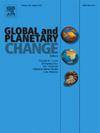Carbonate-mediated terrestrial strontium transport through fresh submarine groundwater discharge into a tropical continental island bay
IF 4
1区 地球科学
Q1 GEOGRAPHY, PHYSICAL
引用次数: 0
Abstract
Fresh submarine groundwater discharge (FSGD) is increasingly recognized as a significant oceanic strontium (Sr) source, yet the role of carbonate-dominated coastal aquifer heterogeneity in modulating Sr mobilization and its impacts on marine Sr cycles remains poorly constrained. Here, we investigate Sr concentrations and 87Sr/86Sr ratios across aquatic systems (rivers, bay water, seawater, and groundwater) in Qinglan Bay, a tropical semi-enclosed bay in Hainan island (China) with lithological diversity. Our data reveal non-conservative mixing dynamics in surface bay water, showing measurable Sr removal (7.7–69.8 %) and 87Sr/86Sr enrichment (+0.000001–0.000334) relative to theoretical mixing models. These deviations are primarily attributed to catchment-scale lithological heterogeneity and adsorption/desorption processes. Integrating Sr-isotope data with lithology- constrained FSGD fluxes, we quantify the FSGD-derived Sr export to Qinglan Bay, revealing an annual flux of 2.39 × 106 mol/yr accompanied by a distinctive 87Sr/86Sr signature of 0.709148. Carbonate weathering dominates this flux, accounting for >99.9 % of the total Sr input. FSGD delivers 2.0–2.1 times more Sr to the bay than riverine inputs, thereby establishing its role as the dominant terrestrial source of Sr. This predominance is likely driven by tropical climate-enhanced weathering and the region's carbonate-dominated sedimentary environment. Building upon this study, we upscale our findings to a global dimension, estimating that tropical continental islands supply 26–47 % of global FSGD-derived Sr fluxes to the ocean—a previously underquantified yet geochemically critical source that reshapes contemporary understanding of marine Sr mass balance.
碳酸盐介导的陆地锶通过新鲜海底地下水排放进入热带大陆岛屿湾
新鲜海底地下水排放(FSGD)越来越被认为是重要的海洋锶(Sr)来源,但碳酸盐主导的沿海含水层非均质性在调节Sr动员及其对海洋Sr循环的影响中的作用仍然知之甚少。本文研究了海南岛热带半封闭海湾青兰湾各水生系统(河流、海湾水、海水和地下水)的Sr浓度和87Sr/86Sr比值。我们的数据揭示了地表水的非保守混合动力学,相对于理论混合模型,显示出可测量的Sr去除(7.7 - 69.8%)和87Sr/86Sr富集(+ 0.000001-0.000334)。这些偏差主要归因于流域尺度的岩性非均质性和吸附/解吸过程。将Sr同位素数据与岩性约束的FSGD通量相结合,我们量化了FSGD向青蓝湾输出的Sr,显示其年通量为2.39 × 106 mol/yr,并伴有明显的87Sr/86Sr特征为0.709148。以碳酸盐风化作用为主,占Sr总输入量的99.9%。FSGD向海湾输送的Sr是河流输入量的2.0-2.1倍,从而确立了其作为主要陆地Sr来源的地位。这种优势可能是由热带气候增强的风化作用和该地区以碳酸盐岩为主的沉积环境驱动的。在这项研究的基础上,我们将我们的研究结果提升到全球层面,估计热带大陆岛屿向海洋提供了26 - 47%的全球fsgd衍生的Sr通量-这是一个以前未被量化但地球化学关键来源,重塑了当代对海洋Sr质量平衡的理解。
本文章由计算机程序翻译,如有差异,请以英文原文为准。
求助全文
约1分钟内获得全文
求助全文
来源期刊

Global and Planetary Change
地学天文-地球科学综合
CiteScore
7.40
自引率
10.30%
发文量
226
审稿时长
63 days
期刊介绍:
The objective of the journal Global and Planetary Change is to provide a multi-disciplinary overview of the processes taking place in the Earth System and involved in planetary change over time. The journal focuses on records of the past and current state of the earth system, and future scenarios , and their link to global environmental change. Regional or process-oriented studies are welcome if they discuss global implications. Topics include, but are not limited to, changes in the dynamics and composition of the atmosphere, oceans and cryosphere, as well as climate change, sea level variation, observations/modelling of Earth processes from deep to (near-)surface and their coupling, global ecology, biogeography and the resilience/thresholds in ecosystems.
Key criteria for the consideration of manuscripts are (a) the relevance for the global scientific community and/or (b) the wider implications for global scale problems, preferably combined with (c) having a significance beyond a single discipline. A clear focus on key processes associated with planetary scale change is strongly encouraged.
Manuscripts can be submitted as either research contributions or as a review article. Every effort should be made towards the presentation of research outcomes in an understandable way for a broad readership.
 求助内容:
求助内容: 应助结果提醒方式:
应助结果提醒方式:


